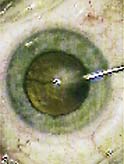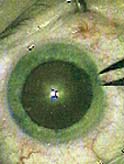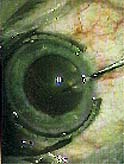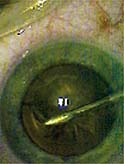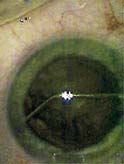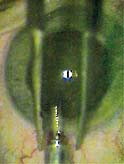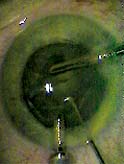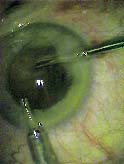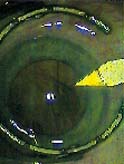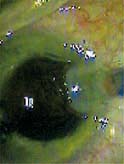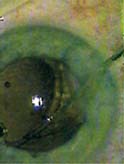Small 1.6-mm cataract incision used with ‘phacosonics’
The STAAR SonicWAVE, in conjunction with the Gravlee Safety Bevel tip, pushes incision size to new limit.
We recently successfully performed small-incision cataract surgery using a non-thermal cataract extraction method through a 1.6-mm temporal clear corneal incision. This is the smallest clinical pre-lens-placement cataract surgery wound that I am aware of, using standard gauge, currently approved, conventional technology.
The equipment used included a 19-gauge (1.1-mm outer diameter) Gravlee Safety Bevel probe in combination with the STAAR Sonic WAVE machine. The procedure was done “unsleeved,” using the “sonic” mode of the STAAR machine. Separate incisions were made for a self-retaining irrigating cannula and for a second instrument, a standard Sinskey hook.
The Gravlee Safety Bevel probe is anti-chatter and anti-surge, with high- efficiency cutting and outstanding occlusion. It works well in the non-thermal, low-energy environment made possible by the SonicWAVE machine. Non-thermal surgery obviates the need for the irrigating sleeve and abolishes the worry of corneal burn morbidity.
Sonic mode employs a vibration frequency of between 50 and 400 Hz. Phacoemulsification employs a vibration frequency of around 40,000 Hz in most machines. Therefore, there is a 200-fold difference in energy release between the two technologies.
Intermolecular friction created by the vibration of phacoemulsification creates a rapid buildup of heat within a standard probe that can lead to corneal burns, even with normal precautions. Standard probe tips were designed more than 30 years ago with a configuration to generate maximal radiating shock (cavitation) waves. (The first phaco machine was even called the Cavitron.)
I feel standard probe tip configuration does not generate enough emulsive energy to remove dense cataracts in the STAAR sonic mode and does not cut well in sonic mode. The Gravlee Safety Bevel cuts extremely well in both low-energy sonic mode and high-energy phaco mode with minimal radiation of waveform energy.
The SonicWAVE can generate high vacuum, yet maintain a stable anti-surge fluidic environment because of proprietary UltraVac coiled tubing and STAAR’s PeriVent technology. The stable high-vacuum environment enhances the pure cutting ability of the Gravlee Safety Bevel probe with little or no power from the hand piece.
The sonic environment is less turbulent than the phaco environment. Also, spinning nuclear fragments are quickly arrested when the Gravlee Safety Bevel probe tip engages, grasps and occludes, leading to aspiration.
New technology, new terminology
This really isn’t phaco anymore. “Non-phaco” is not a good descriptive term so I prefer to call the procedure “phacosonification.”
STAAR Surgical began using the term Sonic to differentiate the new technology from their original Wave phaco machine. The frequency of vibration is within the audible range of human hearing, and therefore Sonic is appropriate to contrast with the ultrasonic frequencies used in phacoemulsification.
The STAAR SonicWAVE machine is thoughtfully designed because it can alternate between delivery of either sonic or ultrasonic energy with a switch in the foot pedal. Power modulations and fluidic settings are programmable though the attached personal computer with touch screen and sterile remote control. Both sonic and ultrasonic energy are delivered through the same four-crystal piezoelectric hand piece. Longer hand piece life span is a result of sonic mode use because of the exponential decrease in mechanical wear and tear.
Case described
The patient on whom we performed our first procedure with the 1.6-mm incision was a 69-year-old woman with a 3+ nucleus. The sonic time was 2.18, and the average power delivered was 10%. Maximum power was set at 40%. Pulse was set at 5/sec throughout the case. Irrigation flow was set at 20 cc/min minimum and 22 cc/min maximum. Vacuum aspiration was set at 140 mm Hg minimum and 160 mm Hg maximum.
The self-retaining 20-gauge cannula was noted to prevent use of higher vacuum settings because of the restriction of inflow created by the small lumen. Future cases may be improved by increasing the lumen size of the irrigating cannula for increased fluid inflow or decreasing the lumen size of the Gravlee Safety Bevel probe for decreased fluid outflow.
The patient’s distance visual acuity was 20/40 uncorrected on postop day 1. On postop day 7, she had 20/25 uncorrected distance vision and 20/20 corrected distance vision with –0.75 sphere.
One week before the sonic procedure, she had undergone hybrid ultrasonic/sonic surgery with a sleeved Gravlee Safety Bevel probe and had obtained 20/20 uncorrected distance vision on postop day 1.
The elapsed case time for the unsleeved case was longer than for the sleeved case due to the short learning curve, allowing greater stromal hydration. I had to widen the unsleeved wound to 2.5 mm in order to accommodate the cartridge injection of a STAAR AQ2010V lens, so both eyes have the same final wound size.
As noted before, this is the smallest clinical pre-lens-placement cataract surgery wound that I am aware of using standard gauge, currently approved, conventional technology. It is exciting to be a part of the continuing evolution of lensectomy/cataract surgery with a safer, low-energy technique.
Avoiding complications
To me, the eye is analogous to a heat sink. It soaks up radiating mechanical waveform energy. Destructive energy into the corneal endothelium causes corneal edema, energy into the iris causes iritis and energy into the retina causes cystoid macular edema. Liquid emulsate and particulate emulsate work through the zonules into the anterior vitreous and also lead to plugging of the trabecular meshwork with postoperative pressure spikes. I like the idea of avoiding these postoperative complications by using a more targeted low-energy technique with vacuum occlusion and cutting as opposed to high-energy emulsion. It is more like delicately carving a sculpture with a chisel, as opposed to using explosives.
The next logical step, pure vacuum cutting, does not allow for any emulsate formation or heat generation. It takes the application of some type of energy to move cataract molecules from point A to point B. Time will tell whether the most efficient form of that energy is cutting, emulsive, hydraulic, mechanical, laser or some combination.
All these technologies will stimulate the development of IOLs that can be inserted through incisions smaller than our current bottleneck of 2.5 mm. More important, though, is that technology is available today with the increased intraoperative safety of smaller incisions, non-thermal energy and decreased destructive radiating waveform emulsive energy.
Earlier work
We have already demonstrated the efficacy of the sleeved Safety Bevel probe with low-power phaco. We performed a study of more than 2,000 traditional phaco surgeries using the Safety Bevel.
We felt the best way to make sense of the data was to calculate the effective phaco power (EPP), the ultrasound time (in seconds) times the average power. Also, the data were more meaningful when patients were grouped into categories according to their preop best-corrected visual acuity before glare testing, the thought being that nuclear sclerosis or hardness of the lens increases as the best corrected vision goes down. With all the categories combined, the overall decrease in EPP was 20.8%. This was significant for both patient and doctor alike.
There has also been a lower vitrectomy rate in traditional phaco surgeries using the Gravlee Safety Bevel probe. Our unplanned vitrectomy rate is 0.3% with the bevel, as opposed to the national average, which is 4% to 6%.
|
|
|
|
|
|
|
|
|
|
|
|
|
|
|
|
For Your Information:
- Joseph F. Gravlee Jr., MD, can be reached at Bay Eyes Cataract and Laser Center, PC, 2 Medical Park, Fairhope, AL 36533-2020; (334) 990-3937; fax: (334) 990-9990; e-mail: gravlee@clearly.com. Dr. Gravlee has a direct financial interest in the Gravlee Safety Bevel as the patent holder (patent number 5,788,679). He has no financial interest in other products mentioned in this article.
- STAAR Surgical, manufacturer of the SonicWAVE system, can be reached at 1911 Walker Ave., Monrovia, CA 91016; (818) 303-7902; fax: (818) 358-9187; Web site: www.staar.com.

